
Illustrative Math Alignment: Grade 7 Unit 8
Probability and Sampling
Lesson 6: Estimating Probabilities Using Simulation
Use the following Media4Math resources with this Illustrative Math lesson.
| Thumbnail Image | Title | Body | Curriculum Topic |
|---|---|---|---|
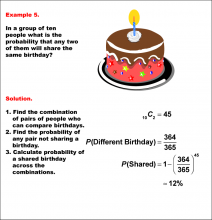
|
Math Example--Probability Concepts--Probabilities Involving Permutations and Combinations--Example 5 | Math Example--Probability Concepts--Probabilities Involving Permutations and Combinations--Example 5
This is part of a collection of math examples that explore different aspects of probability. |
Probability |

|
Math Example--Probability Concepts--Probabilities Involving Permutations and Combinations--Example 6 | Math Example--Probability Concepts--Probabilities Involving Permutations and Combinations--Example 6
This is part of a collection of math examples that explore different aspects of probability. |
Probability |
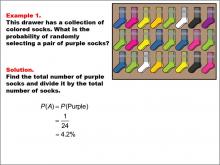
|
Math Example--Probability Concepts--Probability: Example 1 | Math Example--Probability Concepts--Probability: Example 1
This is part of a collection of math examples that explore different aspects of probability. |
Probability |
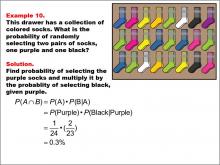
|
Math Example--Probability Concepts--Probability: Example 10 | Math Example--Probability Concepts--Probability: Example 10TopicProbability and Statistics |
Probability |
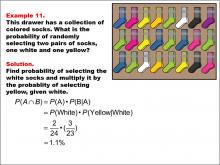
|
Math Example--Probability Concepts--Probability: Example 11 | Math Example--Probability Concepts--Probability: Example 11TopicProbability and Statistics DescriptionThis example involves a drawer filled with socks in colors like blue, pink, yellow, green, white, and black. Students calculate the probability of selecting two pairs of socks: one white and one yellow. They find the probability of selecting white socks first and then multiply it by the probability of selecting yellow socks given that white has already been selected. This exercise introduces conditional probabilities, reinforcing key concepts while providing practical application. Visual aids help students understand these calculations. |
Probability |
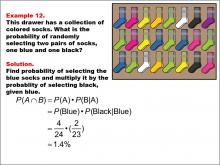
|
Math Example--Probability Concepts--Probability: Example 12 | Math Example--Probability Concepts--Probability: Example 12TopicProbability and Statistics DescriptionThis example presents a drawer with socks in colors like blue, pink, yellow, green, white, and black. Students calculate the probability of selecting two pairs of socks: one blue and one black. They determine the probability of selecting blue socks first and then multiply it by the probability of selecting black socks given that blue has already been selected. This scenario reinforces conditional probabilities and helps students apply these concepts in real-world contexts. |
Probability |
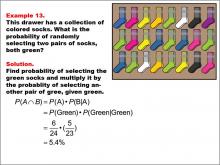
|
Math Example--Probability Concepts--Probability: Example 13 | Math Example--Probability Concepts--Probability: Example 13TopicProbability and Statistics DescriptionThis example features a drawer with colored socks including blue, pink, yellow, green, white, black, and purple. Students calculate the probability of selecting two green socks. They find the probability of selecting green socks first and then multiply it by the probability of selecting another pair given that green has already been selected. This exercise emphasizes conditional probabilities and enhances understanding through visual aids. |
Probability |
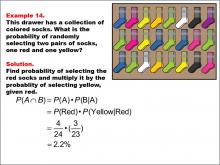
|
Math Example--Probability Concepts--Probability: Example 14 | Math Example--Probability Concepts--Probability: Example 14TopicProbability and Statistics DescriptionThis example shows a drawer with colored socks including blue, pink, yellow, green, white, black, and purple. Students calculate the probability of selecting one red sock and one yellow sock. They determine the probability of selecting red first and then multiply it by the probability of selecting yellow given red. This problem reinforces conditional probabilities using visual aids to clarify solutions. |
Probability |
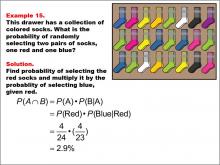
|
Math Example--Probability Concepts--Probability: Example 15 | Math Example--Probability Concepts--Probability: Example 15TopicProbability and Statistics DescriptionThis example involves a drawer with colored socks including blue, pink, yellow, green, white, black, and purple. Students calculate the probability of selecting one red sock and one blue sock. They find the probability of selecting red first and multiply it by the probability of selecting blue given red. This scenario uses conditional probabilities to reinforce learning through visual aids. |
Probability |

|
Math Example--Probability Concepts--Probability: Example 16 | Math Example--Probability Concepts--Probability: Example 16TopicProbability and Statistics DescriptionThis example displays a drawer with colored socks including blue, pink, yellow, green, white, black, and purple. Students calculate the probability of selecting one green pair and one yellow pair. They determine the probability of selecting green first and multiply it by the probability of selecting yellow given green. This exercise emphasizes conditional probabilities using visual aids to enhance understanding. |
Probability |

|
Math Example--Probability Concepts--Probability: Example 17 | Math Example--Probability Concepts--Probability: Example 17TopicProbability and Statistics DescriptionThis example features a drawer with colored socks including blue, pink, yellow, green, white, black, and purple. Students calculate the probability of selecting one green sock and one blue sock. They find the probability of selecting green first and multiply it by the probability of selecting blue given green. Visual aids support understanding as students apply conditional probabilities. For a complete collection of math examples related to Probability click on this link: Math Examples: Probability Collection. |
Probability |
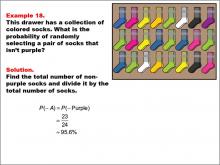
|
Math Example--Probability Concepts--Probability: Example 18 | Math Example--Probability Concepts--Probability: Example 18TopicProbability and Statistics DescriptionThis example presents a drawer with colored socks including blue, pink, yellow, green, white, black, and purple. Students calculate the probability of not selecting purple socks by finding non-purple totals divided by overall totals. This exercise reinforces basic principles while using visual aids for clarity in solving problems involving non-desired outcomes. For a complete collection of math examples related to Probability click on this link: Math Examples: Probability Collection. |
Probability |
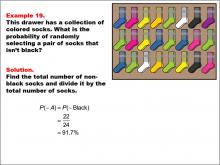
|
Math Example--Probability Concepts--Probability: Example 19 | Math Example--Probability Concepts--Probability: Example 19TopicProbability and Statistics DescriptionThis example involves a drawer filled with socks in colors such as blue, pink, green, yellow, white, and black. Students calculate the probability of selecting socks that are not black by finding the total number of non-black socks and dividing it by the total number of socks. This exercise reinforces basic probability concepts using visual aids to aid understanding. For a complete collection of math examples related to Probability click on this link: Math Examples: Probability Collection. |
Probability |
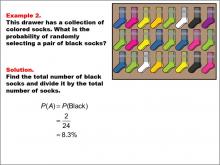
|
Math Example--Probability Concepts--Probability: Example 2 | Math Example--Probability Concepts--Probability: Example 2TopicProbability and Statistics |
Probability |
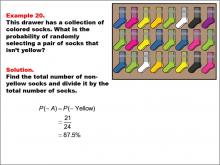
|
Math Example--Probability Concepts--Probability: Example 20 | Math Example--Probability Concepts--Probability: Example 20TopicProbability and Statistics DescriptionThis example presents a drawer filled with various colored socks such as blue, pink, green, yellow, white, and black. Students determine the probability of selecting socks that are not yellow by calculating the total number of non-yellow socks and dividing it by the total number of socks. Visual aids help clarify these calculations. For a complete collection of math examples related to Probability click on this link: Math Examples: Probability Collection. |
Probability |
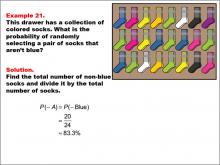
|
Math Example--Probability Concepts--Probability: Example 21 | Math Example--Probability Concepts--Probability: Example 21TopicProbability and Statistics DescriptionThis example features a drawer containing socks in various colors, including blue, pink, green, yellow, white, and black. Students calculate the probability of selecting socks that are not blue by finding the total number of non-blue socks and dividing it by the total number of socks. This exercise uses visual aids to reinforce understanding. For a complete collection of math examples related to Probability click on this link: Math Examples: Probability Collection. |
Probability |

|
Math Example--Probability Concepts--Probability: Example 22 | Math Example--Probability Concepts--Probability: Example 22TopicProbability and Statistics DescriptionThis example involves a drawer with colored socks in pink, yellow, green, blue, white, gray, and black. Students determine the probability of selecting socks that are not green by calculating the total number of non-green socks and dividing it by the total number of socks. Visual aids support these calculations. For a complete collection of math examples related to Probability click on this link: Math Examples: Probability Collection. |
Probability |
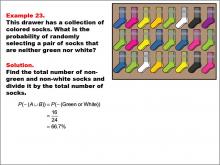
|
Math Example--Probability Concepts--Probability: Example 23 | Math Example--Probability Concepts--Probability: Example 23TopicProbability and Statistics DescriptionThis example presents a drawer with colored socks in pink, yellow, green, blue, white, gray, and black. Students calculate the probability of selecting socks that are neither green nor white by finding the total number of non-green and non-white socks and dividing it by the total number of socks. Visual aids enhance understanding. For a complete collection of math examples related to Probability click on this link: Math Examples: Probability Collection. |
Probability |
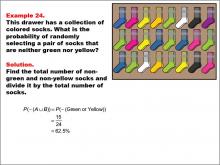
|
Math Example--Probability Concepts--Probability: Example 24 | Math Example--Probability Concepts--Probability: Example 24TopicProbability and Statistics DescriptionThis example features a drawer with colored socks in pink, yellow, green, blue, white, gray, and black. Students determine the probability of selecting socks that are neither green nor yellow by calculating the total number of non-green and non-yellow socks and dividing it by the total number of socks. Visual aids clarify these calculations. For a complete collection of math examples related to Probability click on this link: Math Examples: Probability Collection. |
Probability |
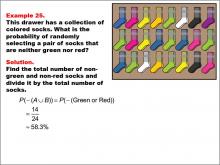
|
Math Example--Probability Concepts--Probability: Example 25 | Math Example--Probability Concepts--Probability: Example 25TopicProbability and Statistics DescriptionThis example involves a drawer containing socks in different colors such as green, red, blue, yellow, white, and gray. Students calculate the probability of selecting socks that are neither green nor red. To solve this, they find the total number of non-green and non-red socks and divide it by the total number of socks. This exercise reinforces basic probability concepts using visual aids to support understanding. Multiple examples like this help students grasp different scenarios, building confidence in their ability to solve similar problems independently. |
Probability |

|
Math Example--Probability Concepts--Probability: Example 26 | Math Example--Probability Concepts--Probability: Example 26TopicProbability and Statistics DescriptionThis example shows a drawer with socks in various colors, including green, blue, black, pink, yellow, white, and gray. It focuses on finding the probability of selecting socks that are not green, blue, or black. Students determine the total number of non-green, non-blue, and non-black socks and divide it by the total number of socks. Visual aids clarify these calculations and reinforce understanding. Seeing multiple worked-out examples helps students develop an intuitive sense for how probabilities work. |
Probability |
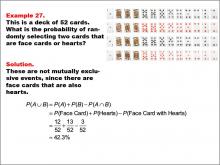
|
Math Example--Probability Concepts--Probability: Example 27 | Math Example--Probability Concepts--Probability: Example 27TopicProbability and Statistics DescriptionThis example features a standard deck of 52 playing cards laid out in rows. It explains how to find the probability of selecting two cards that are either face cards or hearts using probability formulas. Since these events are not mutually exclusive (some face cards are hearts), students must account for overlap in their calculations. This problem illustrates the importance of understanding event exclusivity in probability. Visual aids help students grasp these concepts more effectively. |
Probability |
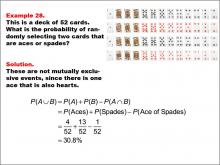
|
Math Example--Probability Concepts--Probability: Example 28 | Math Example--Probability Concepts--Probability: Example 28TopicProbability and Statistics DescriptionThis example involves a deck of 52 playing cards and includes a formula for solving the probability problem. Students calculate the probability of selecting two cards that are aces or spades. Since these events are not mutually exclusive (one ace is also a spade), they must adjust their calculations accordingly. This exercise highlights the need to consider overlapping events in probability calculations. Visual aids provide clarity and reinforce learning through practical application. |
Probability |

|
Math Example--Probability Concepts--Probability: Example 3 | Math Example--Probability Concepts--Probability: Example 3TopicProbability and Statistics |
Probability |
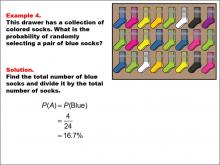
|
Math Example--Probability Concepts--Probability: Example 4 | Math Example--Probability Concepts--Probability: Example 4TopicProbability and Statistics |
Probability |
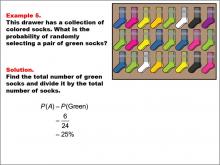
|
Math Example--Probability Concepts--Probability: Example 5 | Math Example--Probability Concepts--Probability: Example 5TopicProbability and Statistics |
Probability |
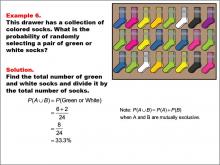
|
Math Example--Probability Concepts--Probability: Example 6 | Math Example--Probability Concepts--Probability: Example 6TopicProbability and Statistics |
Probability |
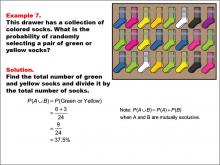
|
Math Example--Probability Concepts--Probability: Example 7 | Math Example--Probability Concepts--Probability: Example 7TopicProbability and Statistics |
Probability |
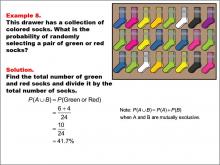
|
Math Example--Probability Concepts--Probability: Example 8 | Math Example--Probability Concepts--Probability: Example 8TopicProbability and Statistics |
Probability |
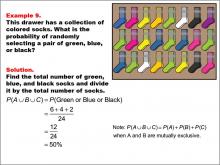
|
Math Example--Probability Concepts--Probability: Example 9 | Math Example--Probability Concepts--Probability: Example 9TopicProbability and Statistics |
Probability |
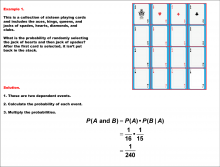
|
Math Example--Probability Concepts--The Probability of Conditional Events--Example 1 | Math Example--Probability Concepts--The Probability of Conditional Events--Example 1
This is part of a collection of math examples that explore different aspects of probability. |
Probability |
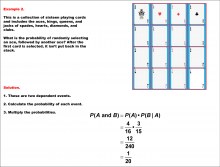
|
Math Example--Probability Concepts--The Probability of Conditional Events--Example 2 | Math Example--Probability Concepts--The Probability of Conditional Events--Example 2
This is part of a collection of math examples that explore different aspects of probability. |
Probability |
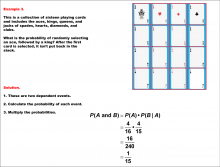
|
Math Example--Probability Concepts--The Probability of Conditional Events--Example 3 | Math Example--Probability Concepts--The Probability of Conditional Events--Example 3
This is part of a collection of math examples that explore different aspects of probability. |
Probability |
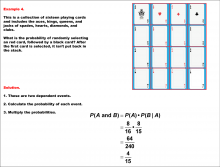
|
Math Example--Probability Concepts--The Probability of Conditional Events--Example 4 | Math Example--Probability Concepts--The Probability of Conditional Events--Example 4
This is part of a collection of math examples that explore different aspects of probability. |
Probability |
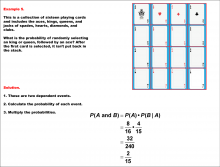
|
Math Example--Probability Concepts--The Probability of Conditional Events--Example 5 | Math Example--Probability Concepts--The Probability of Conditional Events--Example 5
This is part of a collection of math examples that explore different aspects of probability. |
Probability |
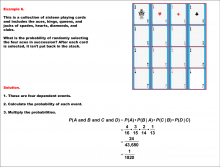
|
Math Example--Probability Concepts--The Probability of Conditional Events--Example 6 | Math Example--Probability Concepts--The Probability of Conditional Events--Example 6
This is part of a collection of math examples that explore different aspects of probability. |
Probability |
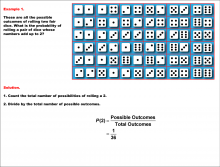
|
Math Example--Probability Concepts--The Probability of Independent Events--Example 1 | Math Example--Probability Concepts--The Probability of Independent Events--Example 1TopicProbability and Statistics DescriptionThis example illustrates a situation where understanding probability through visual aids can greatly enhance learning. Example 1. These are all the possible outcomes of rolling two fair dice. What is the probability of rolling a pair of dice whose numbers add up to 2? Solution: Count total possibilities, divide by total outcomes. |
Probability |

|
Math Example--Probability Concepts--The Probability of Independent Events--Example 10 | Math Example--Probability Concepts--The Probability of Independent Events--Example 10TopicProbability and Statistics |
Probability |
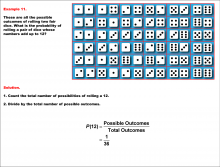
|
Math Example--Probability Concepts--The Probability of Independent Events--Example 11 | Math Example--Probability Concepts--The Probability of Independent Events--Example 11TopicProbability and Statistics |
Probability |
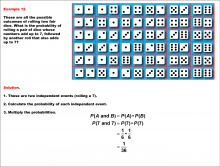
|
Math Example--Probability Concepts--The Probability of Independent Events--Example 12 | Math Example--Probability Concepts--The Probability of Independent Events--Example 12TopicProbability and Statistics |
Probability |
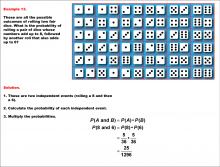
|
Math Example--Probability Concepts--The Probability of Independent Events--Example 13 | Math Example--Probability Concepts--The Probability of Independent Events--Example 13TopicProbability and Statistics |
Probability |
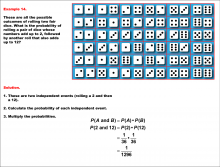
|
Math Example--Probability Concepts--The Probability of Independent Events--Example 14 | Math Example--Probability Concepts--The Probability of Independent Events--Example 14TopicProbability and Statistics |
Probability |

|
Math Example--Probability Concepts--The Probability of Independent Events--Example 15 | Math Example--Probability Concepts--The Probability of Independent Events--Example 15TopicProbability and Statistics |
Probability |
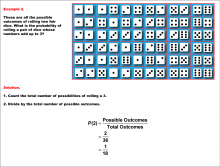
|
Math Example--Probability Concepts--The Probability of Independent Events--Example 2 | Math Example--Probability Concepts--The Probability of Independent Events--Example 2TopicProbability and Statistics |
Probability |

|
Math Example--Probability Concepts--The Probability of Independent Events--Example 3 | Math Example--Probability Concepts--The Probability of Independent Events--Example 3TopicProbability and Statistics |
Probability |
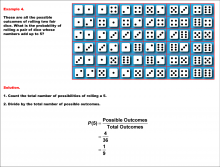
|
Math Example--Probability Concepts--The Probability of Independent Events--Example 4 | Math Example--Probability Concepts--The Probability of Independent Events--Example 4TopicProbability and Statistics |
Probability |
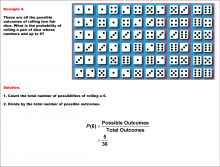
|
Math Example--Probability Concepts--The Probability of Independent Events--Example 5 | Math Example--Probability Concepts--The Probability of Independent Events--Example 5TopicProbability and Statistics |
Probability |
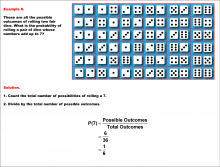
|
Math Example--Probability Concepts--The Probability of Independent Events--Example 6 | Math Example--Probability Concepts--The Probability of Independent Events--Example 6TopicProbability and Statistics |
Probability |
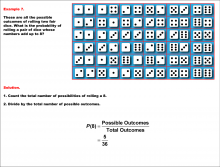
|
Math Example--Probability Concepts--The Probability of Independent Events--Example 7 | Math Example--Probability Concepts--The Probability of Independent Events--Example 7TopicProbability and Statistics |
Probability |
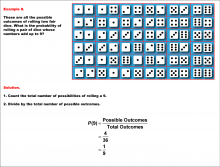
|
Math Example--Probability Concepts--The Probability of Independent Events--Example 8 | Math Example--Probability Concepts--The Probability of Independent Events--Example 8TopicProbability and Statistics |
Probability |